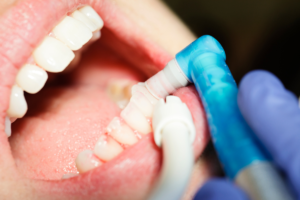Regular dental cleaning is essential for preserving clean, bright teeth, ensuring the ongoing health of your teeth and gums, and proactively preventing problems such as cavities, decay, and even gum disease. This is why visiting your dentist for professional cleanings at least twice a year is advisable.
Occasionally, your dentist at Naples Dental Boutique may suggest a deep cleaning, known as periodontal scaling and root planing. The following sections will delve into the distinctions between these two cleaning methods.
[toc]
 Understanding of Regular Dental Cleaning
Understanding of Regular Dental Cleaning
In a regular dental cleaning, the dentist removes plaque and tartar from the tooth surfaces. This procedure is generally performed without the need for anesthesia and typically spans a duration of 20 minutes to one hour. When you maintain a schedule of regular dental check-ups every six months for cleanings and diligently care for your oral health at home daily, it is less likely that you will ever need deep cleaning.
What Does a Deep Cleaning Procedure Entail?
While regular dental cleaning primarily concentrates on cleaning and polishing the tooth’s surface at or above the gum line, deep cleaning goes further by targeting the removal of tartar and plaque from the tooth’s root, which lies below the gum line. Deep cleaning is typically advised for individuals with a tartar buildup that extends to the tooth roots, leading to symptoms such as inflamed gums, halitosis, and other early indications of gum disease.
What Sets Deep Cleaning Apart from Regular Dental Cleaning?
Varied Objectives in Gum Disease Treatment
Regular dental cleaning primarily aims to preserve overall tooth cleanliness. In contrast, deep cleaning explicitly addresses gum disease or periodontitis, which involves gum tissue recession. Consequently, deep cleaning is typically administered when signs of gum disease are present.
A More Comprehensive Process Conducted Across Two Sessions
The most significant distinction between deep cleaning and regular dental cleaning lies in the thoroughness of the procedure. Unlike a typical dental cleaning, deep cleaning typically involves two appointments. This is because local anesthesia is administered, and the dentist focuses on one side of the mouth during the first and the other during the second.
Unlike the briefer dental cleaning sessions, each deep cleaning appointment typically extends from 40 minutes to one hour, contingent upon the severity of tartar accumulation. Moreover, a deep cleaning is typically conducted in two phases:
- Scaling: This phase involves the meticulous removal of tartar and plaque situated below the gum line, reaching the base of the periodontal pocket.
- Root Planing: During this stage, the tooth’s root surface is meticulously smoothed, facilitating the regrowth and reattachment of connective gum tissue to the tooth’s root. This process helps provide renewed support to the tooth.
Regular Dental Check-Ups Required More Frequently
Another significant distinction between regular dental cleaning and deep cleaning lies in the maintenance schedule. Following a deep cleaning, maintenance visits are required every three months instead of the standard six-month intervals for regular cleaning. This frequent monitoring is essential to prevent the resurgence of bacterial growth.
It’s important to emphasize that regular dental cleaning cannot be performed if the dentist has diagnosed gum disease (periodontitis), as it goes against our professional and ethical standards.
 What Is the Significance of Deep Cleaning?
What Is the Significance of Deep Cleaning?
Neglecting gum disease can eventually result in tooth loss. Thankfully, a deep cleaning, often combined with antibiotics, is generally effective in alleviating inflammation, addressing mild to moderate gum disease cases, and enhancing gum health.
The initial step toward achieving a healthy and attractive smile begins with scheduling an appointment. To do so, please contact our Naples Dental Boutique in Naples, FL, at (239) 399 – 5368, or you can complete an appointment request form.


